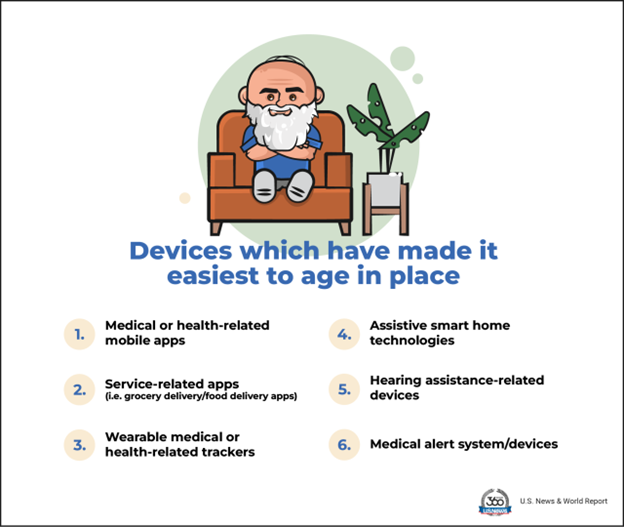The vast majority of older people (95%) want to “age in place” — that is, stay put in their homes and avoid moving into long-term care residences or elsewhere. One approach for enabling aging-in-place is peoples’ adoption of various technologies, a topic surveyed by U.S. News & World Report.

In April 2024, U.S. News interviewed 1,500 U.S. adults ages 55 and over on their views toward technology and everyday life at home.
The first graphic from U.S. News’ study report, published earlier this month, shows that older people identified six categories of devices that have made it easiest to age in place:
- Medical and health-related mobile apps
- Services-related apps, like grocery store deliver
- Wearable medical or health trackers (a la Fitbit)
- Assistive smart home tech, such as Alexa and voice-activated systems
- Hearing assistance devices, and,
- Medical alert systems (i.e., personal emergency response systems/PERS).

Over one-half of older people have adopted assistive or health-related technologies at home. Among those older Americans who have begun to use technologies for health or assistance, the key reasons for doing so have been general aging, addressing mobility impairment (via arthritis, neuromuscular conditions, and so on), hearing impairment, vision impairment, and cognitive impairment (e.g., memory loss).
What matters most to people using these devices, people point to feeling more independent (55%), safer (44%), and healthier (33%).

Getting users’ input into desirable design features is central to creating devices that people will find useful — and be willing to pay for.
Key factors related to using tech’s for aging-in-place included ease of use, ease of set-up, accessibility through a mobile app, being wireless, being voice-activated, and featuring “discreet” product design. That is, devices that look more medical or hospital-purposed would be less desirable to use at-home and in real (non-inpatient or institutional) life.
Health Populi’s Hot Points: On May 23, JAMA Health Forum featured an essay by Stuart Butler, PhD, on Caring for an Aging Population — the Good News and the Bad News. Stuart writes about technologies facilitating safe and more fulfilling home-based aging as a point of optimism for prospects for aging-in-place in America. He points to the CAPABLE social support care program and studies bearing out the cost-effectiveness of this model, among others.
Programs such as Papa and Meals=on-Wheels are also proving out to help people stay at home and thrive.
But to keep building on models for staying at home as we age will require policy changes for public sector programs, such as Medicare and Medicaid, as well as commercial/private sector programs that can support people in aging in novel ways not yet served up in the private sector.
Stuart points to 3 key challenges we should attend to:
- The chronic shortage of caregivers, by restructuring pay for them, simplifying licensing, and improve career ladders/prospects to recruit and retain direct-care workers
- The “crushing” financial burden of institution care for which very few U.S. families have prepared, and,
- “A future Congress and White House will be forced within the next few years to address funding for the rapidly depleting Medicare Hospital Insurance Trust fund,”
and other benefits.
Even the most delightfully designed technologies will be necessary, but not sufficient, to address the aging health citizen demand for remaining and flourishing at-home by the time the last Baby Boomer files for services (medical and Social Security) in 2030.




 Interviewed live on BNN Bloomberg (Canada) on the market for GLP-1 drugs for weight loss and their impact on both the health care system and consumer goods and services -- notably, food, nutrition, retail health, gyms, and other sectors.
Interviewed live on BNN Bloomberg (Canada) on the market for GLP-1 drugs for weight loss and their impact on both the health care system and consumer goods and services -- notably, food, nutrition, retail health, gyms, and other sectors. Thank you, Feedspot, for
Thank you, Feedspot, for  As you may know, I have been splitting work- and living-time between the U.S. and the E.U., most recently living in and working from Brussels. In the month of September 2024, I'll be splitting time between London and other parts of the U.K., and Italy where I'll be working with clients on consumer health, self-care and home care focused on food-as-medicine, digital health, business and scenario planning for the future...
As you may know, I have been splitting work- and living-time between the U.S. and the E.U., most recently living in and working from Brussels. In the month of September 2024, I'll be splitting time between London and other parts of the U.K., and Italy where I'll be working with clients on consumer health, self-care and home care focused on food-as-medicine, digital health, business and scenario planning for the future...